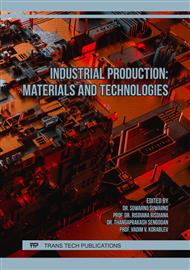p.67
p.83
p.91
p.99
p.107
p.113
p.123
p.129
p.135
The Influence of Microstructure Quality on the Efficiency of Bucket Teeth of Career Excavators
Abstract:
The mining industry is the main base of the country's industrial potential, a significant part of which is the development and production of various rocks and minerals. The main type of machines used in open pit mining are powerful excavators, who make up the bulk of the equipment fleet of mining enterprises. Operating enterprises incur large losses due to wear and destruction of excavator bucket teeth, therefore, improving the quality of the tooth material is an urgent task. This article discusses the influence of the casting quality, including the cast structure of the material, on the performance of the excavator teeth. The object of research was the teeth of the buckets of Cat-391 and VOLVO-350 mining excavators made of 30Cr2Si2MnMo steel after long-term operation. The actual condition of the bucket teeth of mining excavators after operation was examined and microstructure, hardness and worn surfaces of the teeth was analyzed. The study showed that the efficiency of excavator bucket teeth is determined by the level of unevenness of the microstructure and microhardness and the presence of defects, hot and cold cracks. It has been established that the main reason for the accelerated failure of the teeth of open-pit excavator buckets is the superposition of various microstructural defects connected with unevenness of the metal microstructure and imperfection of the casting process. Main directions of increasing efficiency of mining excavators’ teeth bucket were identified.
Info:
Periodical:
Pages:
107-112
Citation:
Online since:
March 2023
Price:
Сopyright:
© 2023 Trans Tech Publications Ltd. All Rights Reserved
Share:
Citation:


